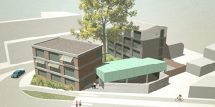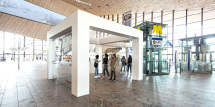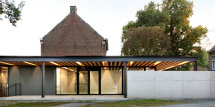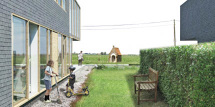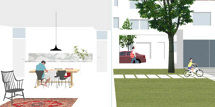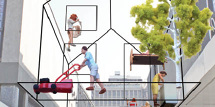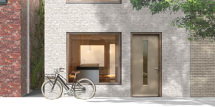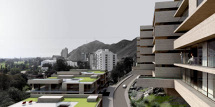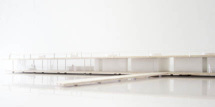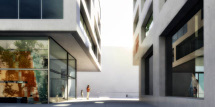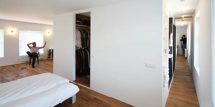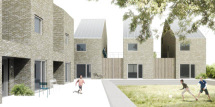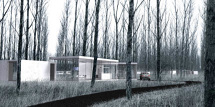INTERVIEW WITH DAVID CHIPPERFIELD
Published in AWM 44 issue 9/10 2011
With the renovation of the Neues Museum in Berlin architect David Chipperfield won both the Europa Nostra Award for European cultural heritage and the Mies van der Rohe Award for contemporary architecture. It is quite remarkable for a restauration project to be evenly successful as a contemporary architecture project. What does this say about the design approach of Chipperfield?
In 2003 you stated that the Neues Museum is the most fascinating project you will ever do. Is that still the case, or are you currently working at equally fascinating projects?
I don't think any project can ever be more fascinating than the Neues Museum. It's more than a normal project because it meant something to the whole country. You're dealing with memory because it was a ruin from the Second World War. If we had just been commissioned to build a new building that wouldn't have had the same reaction as the Neues Museum. When the building opened, people were on their hands and knees and they were touching things. The average visitor stays about two and a half hours, which for museums is unheard of. People feel that there is so much there. That's what ruins have. There's something unfinished, something deeper.
It must have been a very complex project, but it's not very complicated to look at.
It was unbelievably complicated to do. Just putting air conditioning into that building. That was a thesis in itself. We couldn't have a singular solution. So we needed to find specific solutions for every single room. It had to evoke the best out of everybody that was involved in this project. Everybody was involved. People that are not architects can all take people around the building and feel just as strongly about it as I do. They feel it's theirs.
Working on a project this way makes you a kind of specialist for this kind of projects. Last year Alvaro Siza lectured in Rotterdam. He stated that as an architect he is specialized in not being specialized. Is that your professional attitude as well?
Yes. We didn't approach this project as conservation architects. We approached it like architects. I was nervous at the beginning that it would just be ten years of doing restoration. To be honest, we could have done it that way but it wouldn't have been interesting. We provoked our own problems, which made it more interesting. They restored the national gallery recently and restored the Bode museum. Both good restorations by very good architects. They took a more conventional approach.
Is it about falling in love with the context of a project?
That's what is is. The context happened to be very interesting. We paid the price of the approach we took in the process. So much discussion and nervousness about what we were doing. But now we are reaping the benefit from this idea. Even if people don't like it, they're still sort of fascinated. It's difficult to really dislike it. It engages people. Some people I think don't even understand it as an architectural project, they just sort of think the building was like that or something. It doesn't matter, somehow they feel emotionally touched by it.
Did you have the idea that you were trying to design a better building than it had ever been?
The didactic nature of the original wall decorations, a sort of 3D, 2D history of civilization, was completely unacceptable in museological terms. It was already unacceptable in the 1920s. They were already being painting over and they were knocking the building about substantially. Secondly, what can tell you more about the history of civilization than ruination? The worst thing in my opinion would have been trying to recreate the original building with all the decorations. It would not only leave the War out but also a hundred years of historical intellectual development. You would go back to a sort of heroic simplification of history as a linear thing on the walls. You'd have teams of people painting didactic messages which are intellectually way out of time. What's the status of that?
Let's talk about the value of context in your work. You have offices in four country's. Besides the practicality, what's the importance for your projects in having an office in de country you are working in?
The German office came out of the Neues Museum. In ten year we built up an incredible office, with a group of people that is difficult to disband. I'm so impressed by their technical abilities. The Neues Museum has given me a position in Germany that would be wasteful to throw away. I got credibility in Germany that I don't have in England. We are an unique office by being an international practice in Berlin. A hundred percent German in the office, but in a way fifty percent international in our thinking. Foreign offices often have a problem working in Germany because the system and the politics are quite complex. In a way we can give the best of both. We got a sort of openness because we're an international practice, but we the deliverability of a very serious German practice. Having a London office and a Berlin office, with basically a hundred people in both, is much more interesting than having two-hundred people in one space.
Does it also help you to understand local culture and have a extensive narrative?
You can't do things without that. I don't think there would be any reason. We are doing a big project in Korea for a really wonderful client. He's very intelligent and modest. A dream client. I go to Korea a lot and I'm really interesting in finding something which is very of that place. I think we've done a very Korean project.
But it didn't result in an office in Korea?
No. I'm really uninterested in opening offices. It's a horrible idea. My first three buildings were in Japan and I opened an office in Japan. I had more experience building in Japan than I had in Europe. That experience certainly taught me that it's really difficult to keep something running. The Berlin office is the exception. We have a hundred people and christmas parties with their families and children. And that's wonderful. We built up a very personal office. It's a family.
If you build a project for someone in Germany or in England, is that project going to be very different from one in China or Korea? Do you go back to the very universal values which we appreciate all, or is there some sense of local cultural in the plans as well?
I think you can answer that both ways. I think there are certain things that are universal which appeal to everybody. I think it was very formative to me that my first three buildings were in Japan because I didn't know why the hell I was there. Was I trying to copy Japanese architects? It was fine for someone like Frank Gehry to go there, because basically you are buying a Frank Gehry. I didn't have anything to offer at that point. It was formative for me. So therefore I had to try and think about things which I found had a kind of commonality. And I borrowed Ando in a way and Ando helped me. I was interested in what he was doing. But I was really interested in those things which were somehow common. And the idea of making normal things very special. It doesn't matter if you're Chinese, Japanese. My work in Germany is different from my work in America. There's no doubt. And that's a quite difficult thing to explain. It's like getting in a bath. You get in the bath and come out wet. You don't have to explain why you're wet. It's a physical fact. So, you immerse yourself in German culture, but it don't all have to be in your head. It's not your head that's wet, it's your body.
In the Netherlands you did projects in Amsterdam and Almere. Can we expect another project from you in the Netherlands anywhere soon?
I don't have a strong connection with the Netherlands. Of course, I often came here to lecture at the Berlage Institute. I think it's difficult for foreign architects to work in Holland. I like working in Germany because it's very protective and organized. In the Netherlands it's more fluid. Dutch architects are very clever. It's a bit like working in Spain. You've got to somehow duck and dive. And make something on a low budget in a quick way. Dutch architects have to be much more versatile. A German architect is quite protected by the system. Swiss architects are living in a duvet.
You're not exporting a kind of British way of thinking about architecture. In a way your approach is very versatile as well. So, in that sense it's surprising to hear you say that it's difficult to work in the Netherlands.
I find it difficult to work in the UK as well.
One of your current projects is the Naga Museum in Sudan.Why was this project displayed on the cover of your latest el Croquis?
They chose that. You can't do anything with el Croquis. The editors are ruthless. They come inside your office and take what they like. That's why they are so successful. If they call up an archtitects office and say:”Can you send us materials?” They will have to wait. So, they say that they will be coming on tuesday and that they will be there until friday. And then they go home and they make it. So there's not much discussion about what's on the cover.
The building is designed to protect the archeological findings against the elements and looters. Like it's not for people. It seems to be an exceptional project both in terms of context and function.
It is for people, because it gives someone a sense of arrival after driving three hours into de desert. The protected objects will become exhibits. Like your grandmothers attic. The objects won't be exhibited in a museological way. People working on the site will explain things to you. Regarding the shape. It's a stepped thing. Each step brings you higher. At a point you can see over de archeological site. We took a step ladder with us and worked it out.
We thought it is a very interesting project because it looks so non-standard for your work.
I don't think it does actually. It's about core values. Why not reduce something to a basis simple thing? And why don't you take form out of those things? We don't want glass because of the sand. So you evolve how simple something can be. And you go through discussions about what happens to the museum when it's full of sand. And I say: So what. I don't care. I've driven from Khartoum and there's sand all over the floor. But I don't want glass windows which are then broken or need maintenance. So actually it's a ruin. The sands of time can blow through it. ―



